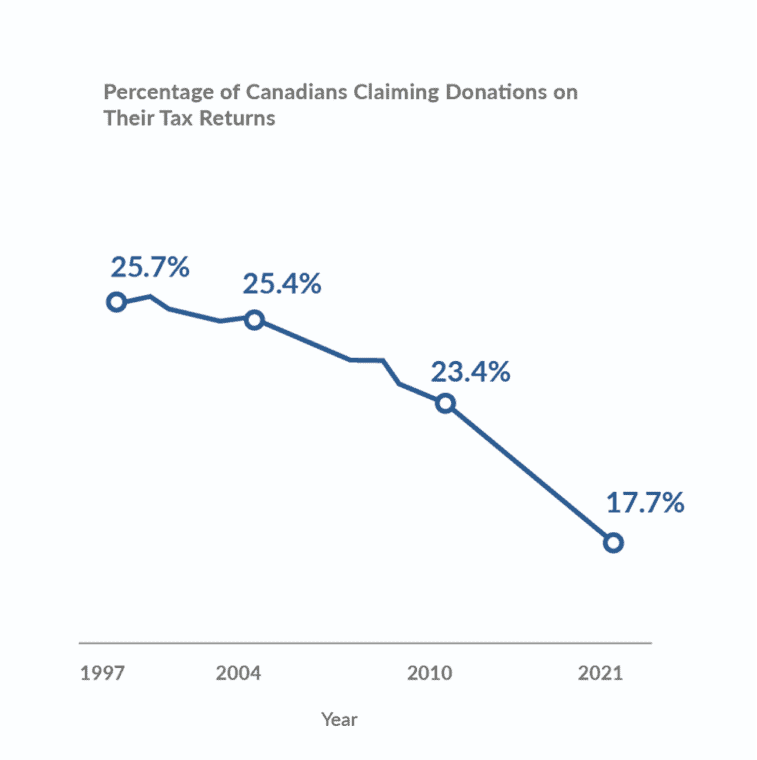The latest CanadaHelps Giving Report reveals that our social bonds are contracting, which is affecting our levels of generosity, including donations to charities. President and CEO Duke Chang offers four steps charities can take to cultivate connected communities.
“It’s a beautiful day in this neighbourhood, a beautiful day for a neighbour. Would you be mine?”
A classic singsong etched in the minds of generations is more than just a catchy tune; it also acts as a lesson that is fundamental to the existence of Canadian charities. Mr. Rogers encouraged us to build relationships with our neighbours, and that is exactly what we need to do to ensure that communities thrive. It’s more than just a nicety: data has indicated a correlation between how connected we are with one another and our levels of generosity within our communities – and that includes donations to charities.
In this year’s edition of The Giving Report from CanadaHelps, we introduced readers to Jessica, a 32-year-old millennial who lives in a small condo, which she shares with her roommate, in the heart of a bustling city. Jessica works from home and joined her current company in the midst of the pandemic, so she has had very few opportunities to meet her colleagues in person to build bonds and get to know them on a personal level. When it comes to causes that Jessica cares about, she is passionate and concerned about the devastating effects of climate change, but she doesn’t do much to turn anxiety into action. She doesn’t attend protests, she doesn’t give to environmental charities, and she doesn’t volunteer.
Our connections and social bonds with one another are contracting, which is affecting how we engage with the world around us.
Jessica is a composite of a wide swath of Canadians in our research and is highlighted in The Giving Report this year because she is a symptom of a greater trend that is taking place across the country: our connections and social bonds with one another are contracting, which is affecting how we engage with the world around us.
From 2013 to 2022, there was a 40% drop in the number of Canadians who reported having six or more close friends. There was also a drop in the number of Canadians who have a strong sense of belonging to their communities, as well as a decline in the number of Canadians who report knowing their neighbours.
Where things get interesting is when we merge this data with giving patterns. Among Canadians who report having zero or one close friend, 53% report making a financial donation to charities, while those who report having two to 10 close friends all give at a higher rate. Sixty-one percent of those with two to four friends, 76% of those with five to six close friends, and 84% of those with seven to 10 friends all report making financial donations to charities. The only anomaly is among Canadians who report having more than 10 close friends, who gave at a lower rate (69%) than those with five or six (76%) close friends or seven to 10 close friends (84%), but at a higher rate than those with zero to one close friends (53%) or two to four close friends (61%).

Among overall giving trends, charities are seeing fewer and fewer Canadians give. Tax-filer data from 2010 reported that 23.4% of Canadians gave to charities. By 2021, the number of Canadians claiming charitable tax receipts on their income tax dropped to 17.7%. Although there are limitations to the use of tax-filer data, it points to a worrisome decline that needs to be put into reverse. The overreliance on fewer Canadians to open up their pocketbooks, write hefty cheques – or in 2024 terms, tap their phones – is a threat to the nation’s charities, and by extension, the entire social fabric of communities across the country.

While our connections to one another are an important factor in this decline, it’s not the only reason behind these trends. Other reasons include economic uncertainty and the ongoing affordability crisis, in addition to declining religiosity, changing giving patterns among young Canadians, and donors not feeling that their gifts are making an impact due to a lack of information.
These are broad issues that are beyond the control of any individual person or charity, but there are steps we can take to drive change. Here are four ways that your charity can take action:
1. Building communities, one conversation at a time
Rome wasn’t built in a day, and neither were communities. It’s going to take time to build back and build better connections with one another to ensure that our communities thrive, leaning into the lessons taught to us by Mr. Rogers.
Every opportunity there is to bring people together should be leveraged.
For charities, this means that every opportunity there is to bring people together should be leveraged. Bring your team and supporters together for events or in-person gatherings to cultivate the communities around you and ensure that bonds are built so everyone can feel like they belong.
2. Communicating success and impact is key
If you don’t share your impact, your supporters won’t know about it – it’s as simple as that.
The Giving Report highlights how 20% of Canadians who previously gave to environmental charities stopped because they doubted the effectiveness of their donations. No matter the cause, charities must leverage data and stories and keep supporters updated in terms of both the challenges they can help you tackle and the impact that they are going to have when they give. This will not only highlight how successful your organization is; it will also provide your supporters hope, which is critical.
It’s important to leverage the success and impact of your organization to give supporters hope and a desire to support your mission.
The report also highlights that 18% of Canadians who are very hopeful for Canada’s future donated to environmental charities. Among Canadians who identify with feelings of hopelessness toward Canada’s future, only 1% donated to environmental charities. While these two examples are focused on environmental causes, we can extrapolate these findings and apply them to other causes. It’s important to leverage the success and impact of your organization to give supporters hope and a desire to support your mission.
3. Reduce barriers to entry
We need to examine how supporters make their first interactions with our organizations.
If your charity is asking only for money, a supporter’s financial situation may be standing in the way of their making their first gift. Instead, encourage both financial donations and other ways to get involved like volunteering, advocating on behalf of your organization, or sharing their knowledge and expertise in a specific area.
A non-monetary way of supporting your organization can strengthen the relationship with your supporters and lower the barrier to entry.
While financial support is undoubtedly important, a non-monetary way of supporting your organization can strengthen the relationship with your supporters and lower the barrier to entry. Broader involvement can help supporters see the impact of your organization’s work and may open doors for financial donations when they have more disposable income in their bank accounts.
4. Get proactive
For many charities responding to emerging needs or crises such as providing humanitarian relief, distributing emergency shelter services, or funding mental health therapy or emergency food banks, it can often feel like there is not enough time to focus on prevention or systemic change.
Consider ways of soliciting longer-term support for your charity by explaining how supporters can help prevent or reduce the emergent burden in the first place.
While fundraising for immediate needs for urgent situations is critical, consider ways of soliciting longer-term support for your charity by explaining to supporters how they can help prevent or reduce the emergent burden in the first place.
For example, Michael Bernstein, the executive director of Clean Prosperity, suggests that when fundraising for urgent relief like a wildfire, encourage donors to increase their gift to help fund solution-focused work, such as advocating for policies to proactively tackle climate change.
We all have the power as leaders in Canada’s charitable sector to take steps toward the change we want to see. Like Mr. Rogers taught a generation of kids, understanding the unique value that each of us offers is what makes communities strong, and strong communities help us all.

